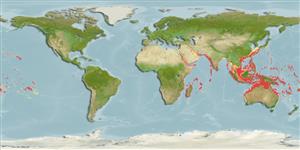Common names from other countries
Environment: milieu / climate zone / depth range / distribution range
Ecologia
marinhas associadas(os) a recifes; intervalo de profundidade 2 - 171 m (Ref. 1602). Tropical; 30°N - 28°S
Indo-Pacific: Red Sea and East Africa to the Hawaiian, Marquesan, and Ducie islands, north to southern Japan, south to the Great Barrier Reef and Lord Howe Island. Throughout Micronesia.
Tamanho / Peso / Idade
Maturity: Lm ? range ? - ? cm
Max length : 30.0 cm TL macho/indeterminado; (Ref. 5372); idade máx. registrada: 10 anos (Ref. 72479)
Espinhos dorsais (total) : 12; Raios dorsais (total) : 24 - 27; Espinhos anais: 3; Raios anais : 19 - 22. The dorsal caudal and anal fins are bright yellow. Body color is white with a black elliptical marking along the edge of the posterior portion of the back extending across the caudal peduncle to the base of the posterior anal fin rays. A series of thin vertical black lines run across the sides, and a prominent vertical black band runs across the eye (Ref. 4855). Snout length 2.0-2.7 in HL. Body depth 1.4-1.7 in SL (Ref. 90102).
Occur in lagoon and seaward reefs, usually in pairs in coral rich areas (Ref. 1602). Benthopelagic (Ref. 58302). Feed mainly on coral polyps and anemones, but also on small invertebrates and algae (Ref. 1602). Largest species in the genus (Ref. 9710). Oviparous (Ref. 205). Form pairs during breeding (Ref. 205).
Ciclo de vida ou comportamento de acasalamento
Maturities | Reprodução | Spawnings | Egg(s) | Fecundities | Larvas
Distinct pairing (Ref. 205). Monogamous mating is observed as both obligate and social (Ref. 52884).
Steene, R.C., 1978. Butterfly and angelfishes of the world. A.H. & A.W. Reed Pty Ltd., Australia. vol. 1. 144 p. (Ref. 4859)
Status na Lista Vermelha da UICN (Ref. 130435)
CITES (Ref. 128078)
Not Evaluated
Ameaça para os humanos
Harmless
Uso pelos humanos
Pescarias: pouco comercial; Aquário: Espécies comerciais
Ferramentas
Relatórios especiais
Baixar XML
Fontes da internet
Estimates based on models
Preferred temperature (Ref.
115969): 23.7 - 28.9, mean 27.6 (based on 1534 cells).
Índice de diversidade filogenética (Ref.
82804): PD
50 = 0.5000 [Uniqueness, from 0.5 = low to 2.0 = high].
Bayesian length-weight: a=0.02291 (0.01388 - 0.03781), b=2.94 (2.80 - 3.08), in cm Total Length, based on LWR estimates for this species & Genus-body shape (Ref.
93245).
Nível Trófico (Ref.
69278): 3.4 ±0.55 se; based on food items.
Resiliência (Ref.
120179): Elevada, tempo mínimo de duplicação da população menor que 15 meses (Preliminary K or Fecundity.).
Fishing Vulnerability (Ref.
59153): Low vulnerability (20 of 100).
